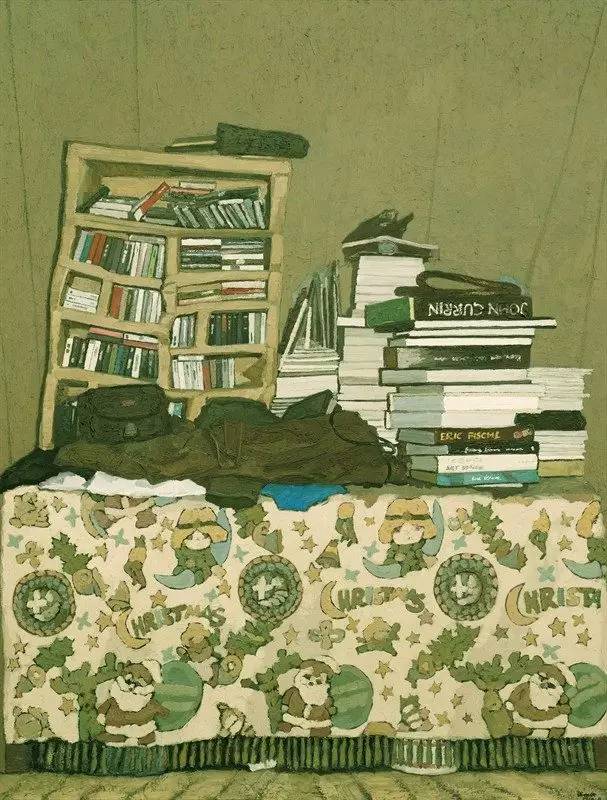
The Anomaly of the Cramped Space by Liu Libin
Liu LIbin
2013.06
"Theater" is the theme of Zhang Yexing's paintings. He creates cramped space one by one by choosing certain spots where the people are an anomaly.
The story from Plato's most famous book, The Republic:The Allegory of the Cave, is about human beings living in an underground den that has its mouth open towards the light and reaches all along the den; here they have been since childhood and have their legs and necks chained so that they cannot move and can only see before them, being prevented by the chains from turning heads. Above and behind them a fire is blazing at a distance, and between the fire and the prisoners there is a raised way; you will see, if you look, a low wall built along the way like the screen that marionette players have in front of them over which they show the puppets. Men passing along the wall carrying all sorts of vessels, and statues and figures of animals made of wood, stone, and various materials that appear over the wall. Some of the men are talking, others are silent. Now look again and see what will naturally follow if the prisoners are released and disabused from their error. At first, when any of them is liberated and compelled to suddenly stand up and turn his neck around and walk towards the light, he will suffer sharp pains; the glare will distress him and he will be unable to see the realities of which, in his former state, he had seen in the shadows. Then consider someone saying to him, that what he saw before was an illusion and that now, when he is nearer to being and his eye is turned towards real existence he has a clearer vision, what will be his reply be? And you may further imagine that his instructor is pointing to the objects as they pass and requiring him to name them, -- will he not be perplexed? Will he not fancy that the shadows which he formerly saw are truer than the objects which are now shown to him?
Zhang Yexing should be the man having seen the "Sun" already. After seeing the “Sun” he returns to the "Cave", and replaces the "Cave" with a "Theater", becoming one of the men carrying the vessels. But he was not a still, silent one; he continuously changed his postures while carrying.. He intended to inspire those prisoners by letting them watch and, on the other hand, constantly alerted himself to not forget the moment of seeing the sun. ZhangYeXing continues to break the boundaries of the "vision" and the "truth", and combined them together now and then. So, ZhangYeXing' paintings show strong surrealism, which is the basic tone of his paintings. In "theatre", a virtual space, there is a conflict between the logical of surrealistic and the awareness of the author: to contract with his awareness, the original piece of the "caves" became bizarre, and he has shown this quality ceaselessly in his "theaters", making the original uncanniness. The misfit and stimulation of the audiences is just the same as the prisoners---- the audiences obviously felt the existence of bounding chains and close ties and on the other hand, amazed by the unusual performance of the characters.
The "curtain" is the important tool in ZhangYeXing's paintings and is similar to the wall of the cave, the "real" faced by the prisoners day and night. In the paintings, the back and front of the curtain is the main place for the person to be active, meantime, it is the good means for ZhangYeXing to create such cramped space. His story is developed in the back and front of the curtain, just like audiences watching in real theaters. "Curtain" is originally used as a cover tool to switch the performance, but in ZhangYeXing's painting, it has become an effective interlayer to realize the real and the fake society. The crushing for the "curtain" is the longing for the "real", just like the natives' destruction for the film curtain to destroy the "real" which they cannot accept. The only thing is that one is ignorance but the other is conscious. In exposing the real, ZhangYeXing recreated a surreal field: Castro proclaiming socialism is good in the empty theatre, the stork flying up and hovering in the sleepers' dream, daggers and olive hiding under the belly of the leaping horse, just like the imprisoned stage staff facing the empty theatre and back to the curtain. People enjoy Zhang Yexing's works but confused by his unusual scenes. Zhang Yexing floats through the bound of "real" and "unreal" and let such "floating" be doubled.
There are not many people in Zhang Yexing's paintings, but most of them show their back to the audience. These people are in a callous or exhausted state, standing or sitting down and looking ahead which should be unknown, empty or his eyes closed. None of the viewer is absent; the artist left the audiences' position to the people enjoying the works, which is doomed to be the one-man skits. The artist creates a theatre without audience which is in an awkward condition and wants to reflect his own thinking and living condition. In this seemingly lonely space hides much more anomaly. In the <three women>, three sexy feet are stretched out from the seat. Bound sexy body, brilliant gorgeous color known as political field are combined together to express the humor and cramped space.
The cramped space made by Zhang Yexing shows anomaly and humor. Plato's "caves" is stirred by Zhang Yexing then became the unfamiliar "theatre".
